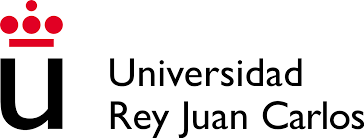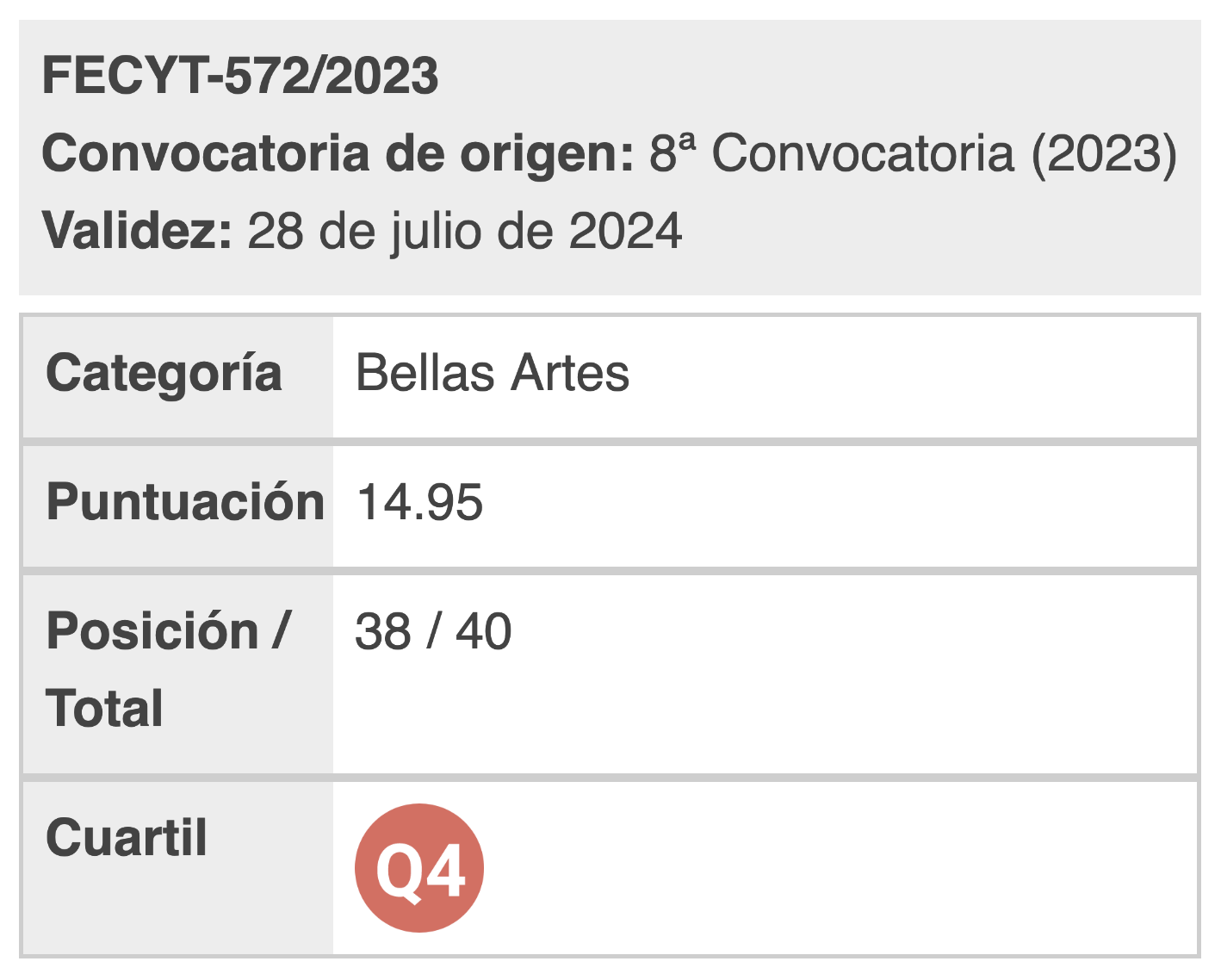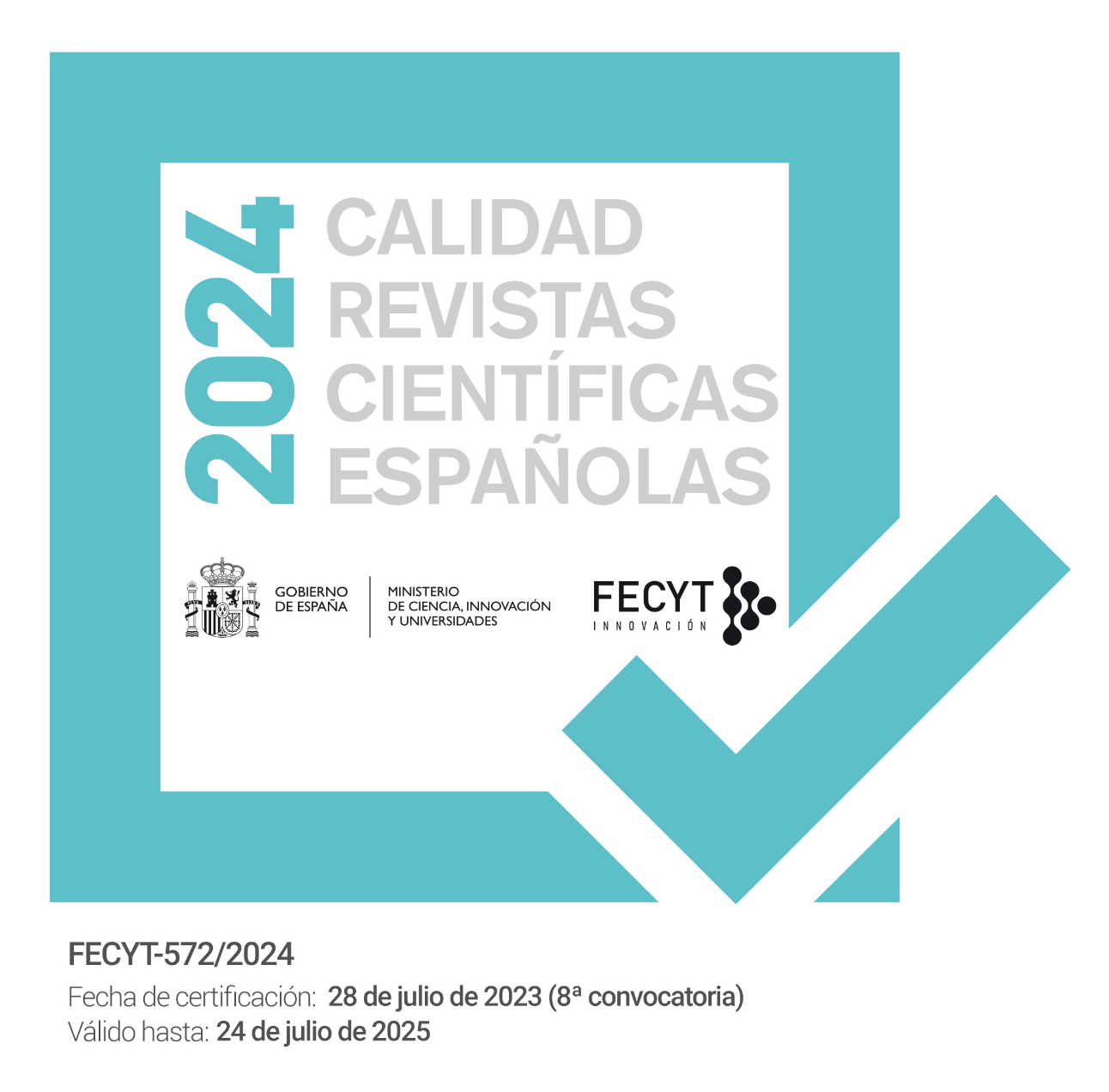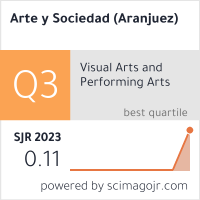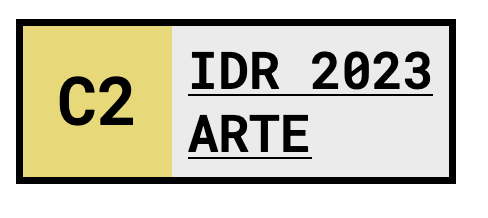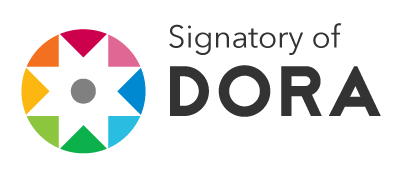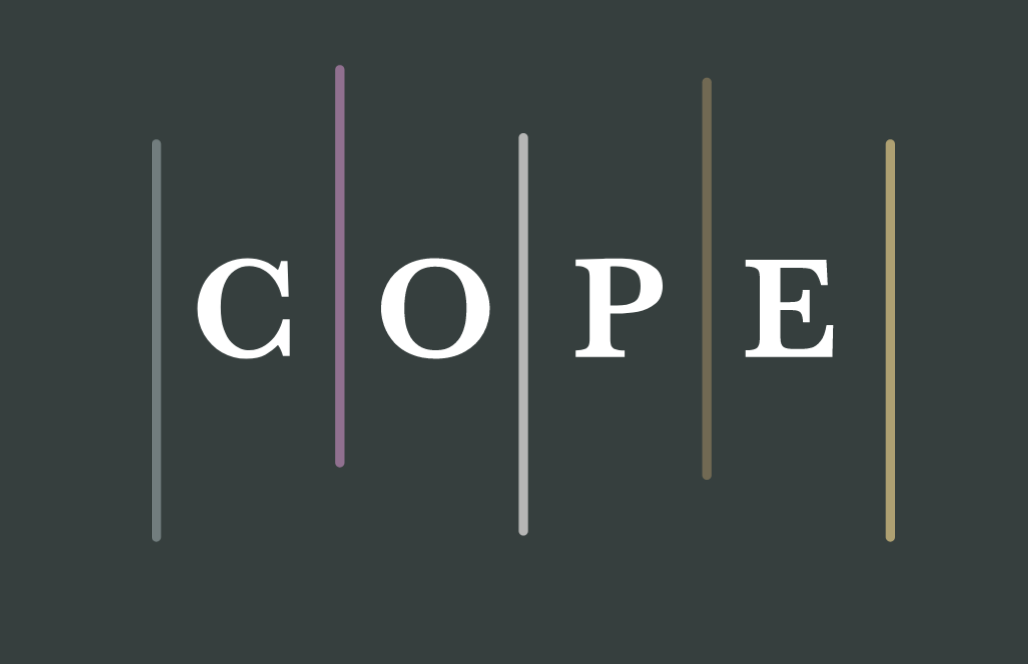ISSN: 2174-7563
Archives
-
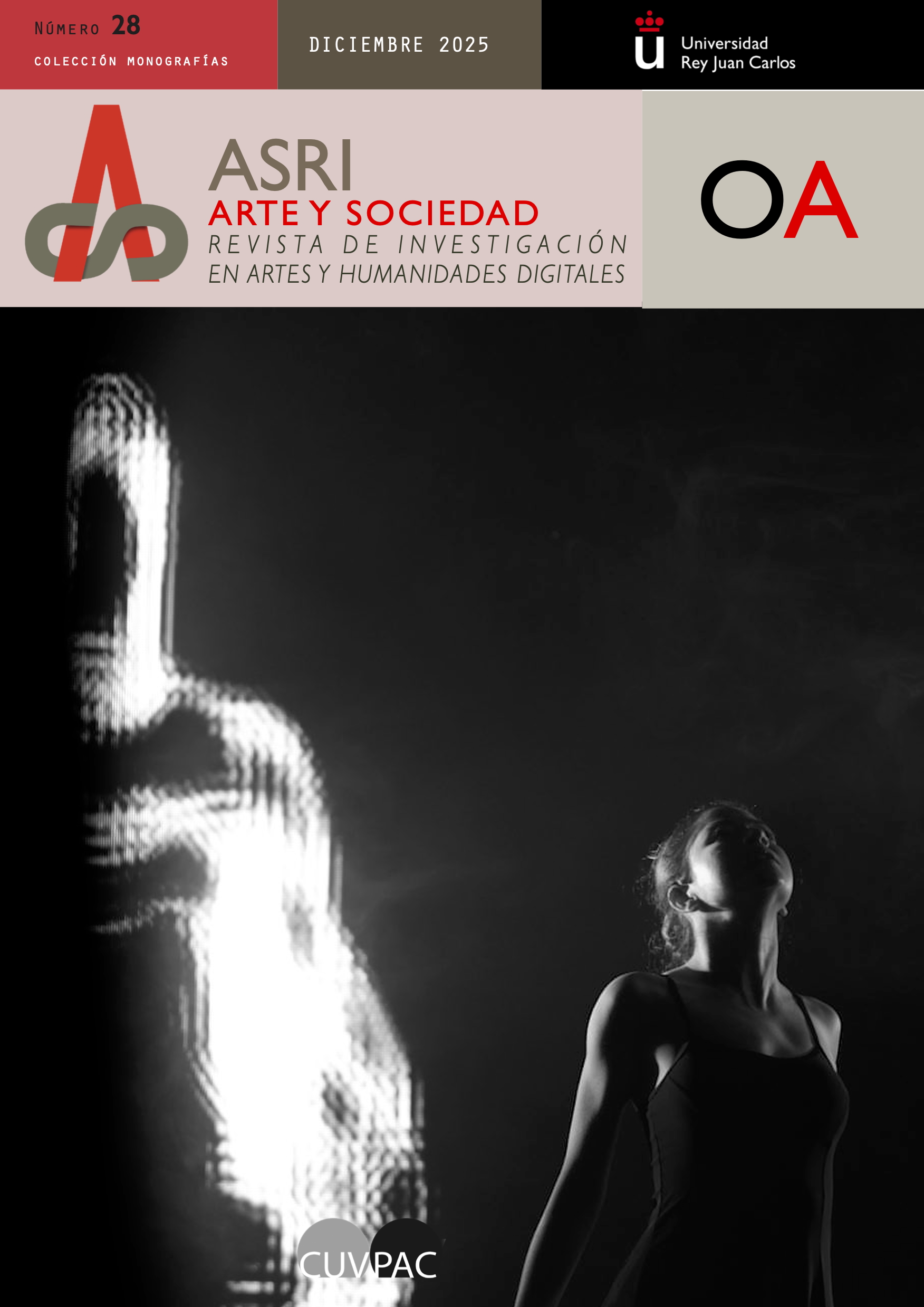
Spatial characteristics in digital scenographic installations
No. 28 (2025)This special issue presents a multidisciplinary and transversal analysis of the new spatiality that has been emerging since the 1980s, and especially during the 21st century, in various scenographic installations (artistic, cultural, performing, and audiovisual), due to the disruptive incorporation of digital software: video mapping, stage robots, sound environments, augmented reality, 3D modeling and projection, 360-degree viewing, holograms, and so on. This innovative multimedia management has fostered previously unthinkable possibilities for expression and visual configurations. The stage becomes as illusionistic and immersive as in Italian theater, while, paradoxically, becoming more interactive. Digital technological resources prolong the scenographic renewal proposed throughout the 20th century, from Appia and Craig to Wilson and Lepage, who expanded the text with the object, the spectator, the light, and the image. This led to the experimentation of new theatre models, such as the Festspielhaus Hellerau (1911) by Tessenow and Dalcroze, Kiesler's Endless Theatre (1924), Gropius's Teatro Total (1926), or Le Corbusier's "espace indicible" (1948), the "boîte à miracles" and the Philips Pavilion (1958). This was followed by the post-avant-garde movements of the 1960s, with the hybrid format of art installations and the prominence of light (Flavin, Turrel, Eliasson) and video (Nam June Paik, Bill Viola). In Italian theatre, multimedia movements such as Nono, Kaslik and Svovoda (Venice 1961), Puecher (Pavia 1967) and Carmelo Bene (Milan 1974) emerged. In the 1980s, the "Electronic Arts Festival" (Rennes, 1988) and the total spectacles of "La Fura dels Baus" and its "Binary Manifesto" were decisive. In the 21st century, software has already enabled dizzying real-time interaction (The Sphere, 2023).
The coordination of this monograph has been made possible thanks to the collaboration of the research groups ESPACIAR (University of Valladolid) and CUVPAC (Rey Juan Carlos University).
-
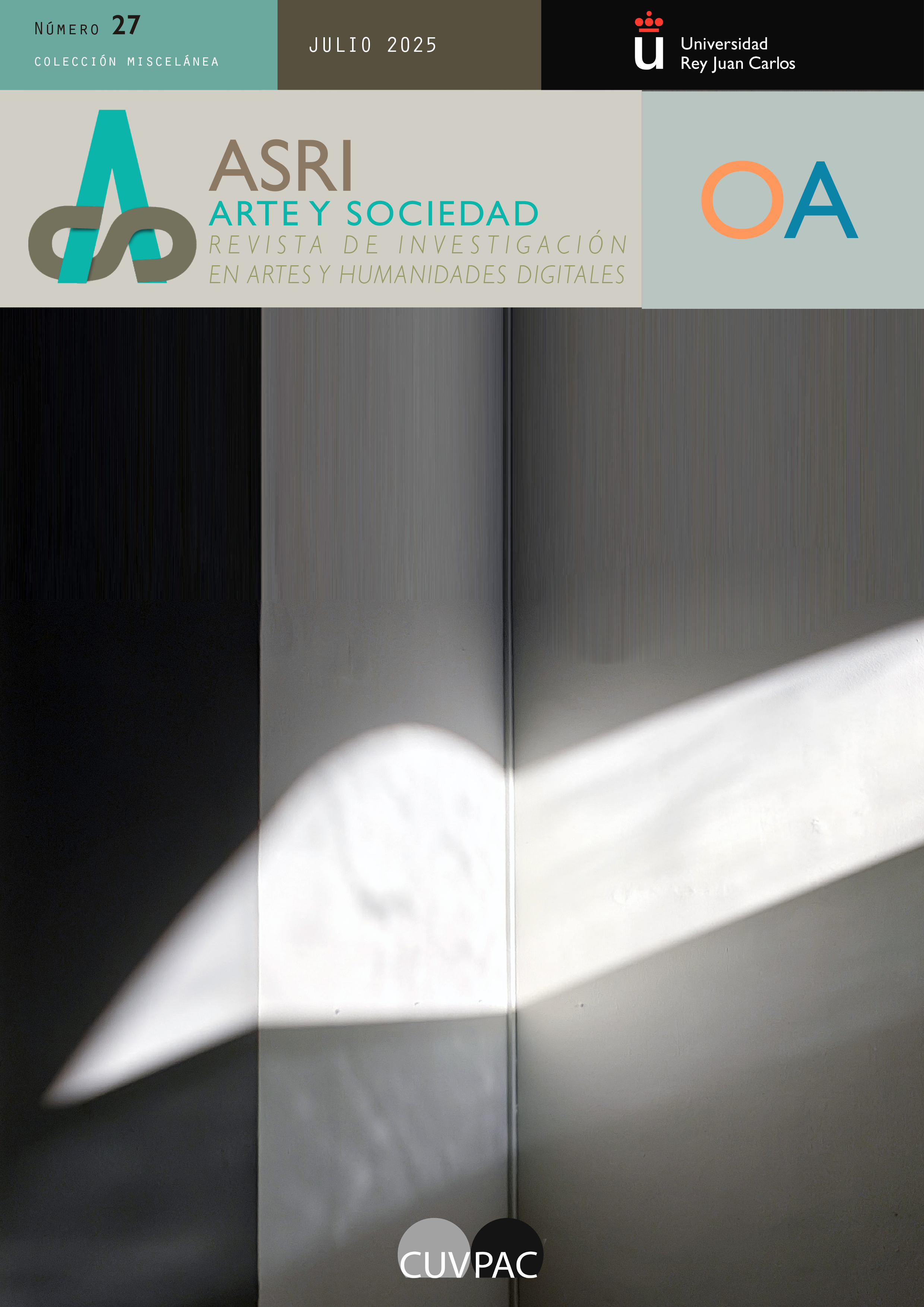
OpenASRI. Misceláneous Journal
No. 27 (2025)This issue of ASRI brings together a selection of research articles that, from diverse perspectives and interdisciplinary approaches, reflect on the transformations of art, visual culture, and gender studies in the digital era and within specific historical and territorial contexts. The contributions presented here demonstrate how technology, memory, identity, and social dynamics continue to shape contemporary artistic and communicative processes, expanding the boundaries of creative practice and critical thought.
The opening article examines the profound transformation of the body in contemporary performing arts resulting from the emergence of digital technologies. It analyzes new forms of performativity that arise from the interaction between performers and technological environments, as well as key concepts such as techno-presence and posthumanist performance. Through emblematic cases—from automated stage productions to immersive virtual reality experiences—it discusses how these innovations expand the relationship between the physical and the virtual, reshaping dramaturgy and the audience’s experience.
Continuing this line of reflection, another contribution focuses on the notion of the spectacular in contemporary art, particularly in light of the rapid development of AI-generated imagery. The study identifies three core characteristics of such performative practices: the use of large-scale immersive formats, the deliberate pursuit of visibility and attention, and the deployment of excessive and repetitive visual forms. This analysis invites readers to consider how technological spectacularity is redefining modes of perception and audience engagement.
The impact of algorithmic systems on contemporary visual culture is explored in another article that introduces the concept of the “algorithmic styleme.” From a semiotic and transdisciplinary perspective, the study examines how audiovisual platforms—exemplified by Netflix—not only respond to consumption patterns but actively shape them, influencing aesthetic decisions and configuring cultural production and reception dynamics within the framework of digital capitalism and the attention economy.
The history and evolution of teaching tools for artistic anatomy is the focus of another contribution. This historical overview, spanning from classical Greece to the current digital age, analyzes key milestones such as the transition from classical ideals to individualized representations in Roman times, the use of cadavers in Renaissance universities, the incorporation of photography to understand bodily movement, and the development of three-dimensional digital models. The study offers a historical and pedagogical perspective on the construction of anatomical knowledge in Western culture.
Graphic heritage and visual communication are addressed through a study of popular lettering and signage in Latacunga, Ecuador. Using a qualitative and descriptive approach, the article analyzes the visual, symbolic, and contextual characteristics of traditional signage, emphasizing its role as an identity marker and heritage element within an urban environment challenged by the pressures of the digital era.
From a gender studies perspective, another article analyzes the representation of female protagonists in the television series The Marvelous Mrs. Maisel. Through textual and phenomenological analysis, it examines the physical, psychological, and social dimensions of the characters, assessing their alignment with feminist principles and the persistence of sexist stereotypes. The findings conclude that the series offers a critical reinterpretation of the 1950s, depicting women who challenge patriarchy through artistic and professional independence.
The relationship between art, territory, and social transformation is the subject of an ethnographic study on painting practices in the indigenous Andean communities of Tigua, Ecuador. Since the late 20th century, this artistic practice has become both an economic and symbolic resource, reshaping community relations, social hierarchies, and local development dynamics, demonstrating the power of art to foster visibility and reorganization in post-agrarian rural contexts.
Andean biodiversity and its potential to inspire artistic creation and design are examined in an article on the flora of Chimborazo. The study identifies unique patterns, textures, and colors in local plant species that, when deconstructed, generate sustainable aesthetic solutions integrating cultural identity and natural heritage.
Finally, the memory embedded in the materiality of images is analyzed through a dialogue between conservation-restoration practices and contemporary artistic approaches based on photographic archives. The article highlights how artists and conservators converge in reclaiming the traces of time and constructing counter-hegemonic narratives that enrich the historical and aesthetic understanding of photography.
Collectively, these studies broaden current debates on art, technology, gender, heritage, and memory, offering critical perspectives that help us understand cultural processes in constant transformation. This issue of ASRI thus reaffirms its commitment to interdisciplinary research and the dissemination of innovative approaches that engage with contemporary challenges in the arts and digital humanities.
Editors: Tomás Zarza Núñez & Miguel Sánchez-Moñita
-
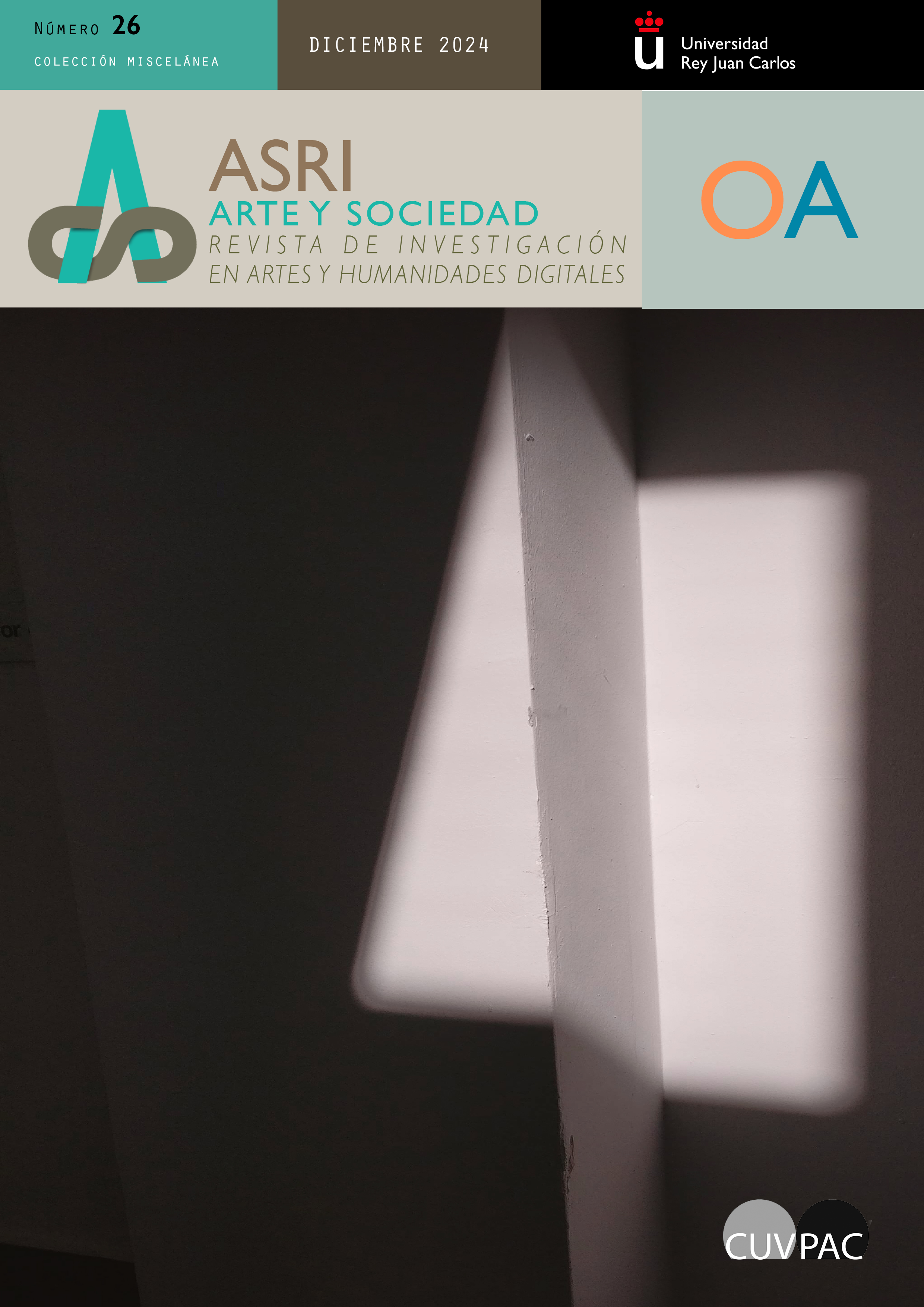
OpenASRI. Misceláneous Journal
No. 26 (2024)Memory, Myth and Technology: Reflections on Art, Communication and Society
This issue offers an interdisciplinary exploration of the intersections between art, technology, and culture. It encompasses topics from augmented reality to artificial intelligence, as well as cinema, photography, data analysis, and screen culture. Through ten articles, 13 authorships, and more than eleven universities —five of them international—, we examine how these dynamics reshape our perception of the world and creative practices in an ever-evolving context.
We begin with a reflection on augmented images, which, supported by augmented reality technology, not only transform the representation of reality but also generate new and superlative realities. This phenomenon raises questions about the scope and potential of manipulated images in constant circulation. In the realm of cinema, we delve into title sequences as condensed expressions of filmmakers’ and producers’ narrative and visual styles. Specifically, an analysis of Saul Bass’s work in the animated film Monsters, Inc. explores the creative connections between Disney, Pixar, and this renowned graphic designer. These microstructures, as termed by Zunzunegui, are more than introductions; they are narratives in their own right. In art, we focus on titles and labels, elements often underestimated yet crucial in contextualizing and connecting with diverse audiences. We highlight their autonomous value as creative tools capable of enriching the aesthetic experience.
From a cultural standpoint, we address Chilean journalistic narratives about the earthquakes of 1960 and 2010. This study reveals how disaster memory becomes a “seismic myth” embodying the hope of rebirth after devastation. Simultaneously, we reflect on the Metaverse, questioning whether this new virtual city perpetuates contemporary architecture's failures by prioritizing economic interests over social welfare and sustainability. In another domain, we analyze the impact of NFTs on digital art. Although initially revolutionary for their ability to individualize works and ensure traceability, the NFT market has experienced a speculative crisis. This underscores the urgency of establishing clear legal frameworks to protect creators and collectors.
Historically, we observe the relationship between tourism and photography in the 19th century. We highlight how Kodak’s popularization of cameras not only democratized access to visual documentation of travels but also shaped a new tourist gaze, still influential in our visual culture today. Finally, in the realm of artistic creation, we explore two critical lines regarding the impact of digital technologies. On one hand, we address how images generated through massive data analysis acquire an imperative character, shaping action models and redefining the concept of images as "numerical hallucinations." This reflection draws on theories from authors such as Flusser and Yuk Hui, offering a new perspective from media archaeology. On the other hand, we analyze how the screen has become the dominant mode of contemporary culture. From cinematic and television formats to mobile devices, the screen not only acts as a medium but also transforms our interaction with reality, prioritizing emotional perception over rational thought. This phenomenon culminates in the configuration of the Homo Digital, a being adapted to existence within the screen's environment.
Together, this issue invites readers to reflect on how technological innovations impact our way of seeing, creating, and understanding art, culture, and the world around us. From visual manipulation to artificial intelligence, spanning cinema, photography, and screen culture, we explore the intersections between tradition and modernity. We hope you enjoy it as much as we did preparing it.
Editors: Tomás Zarza and Miguel Sánchez-Moñita
-
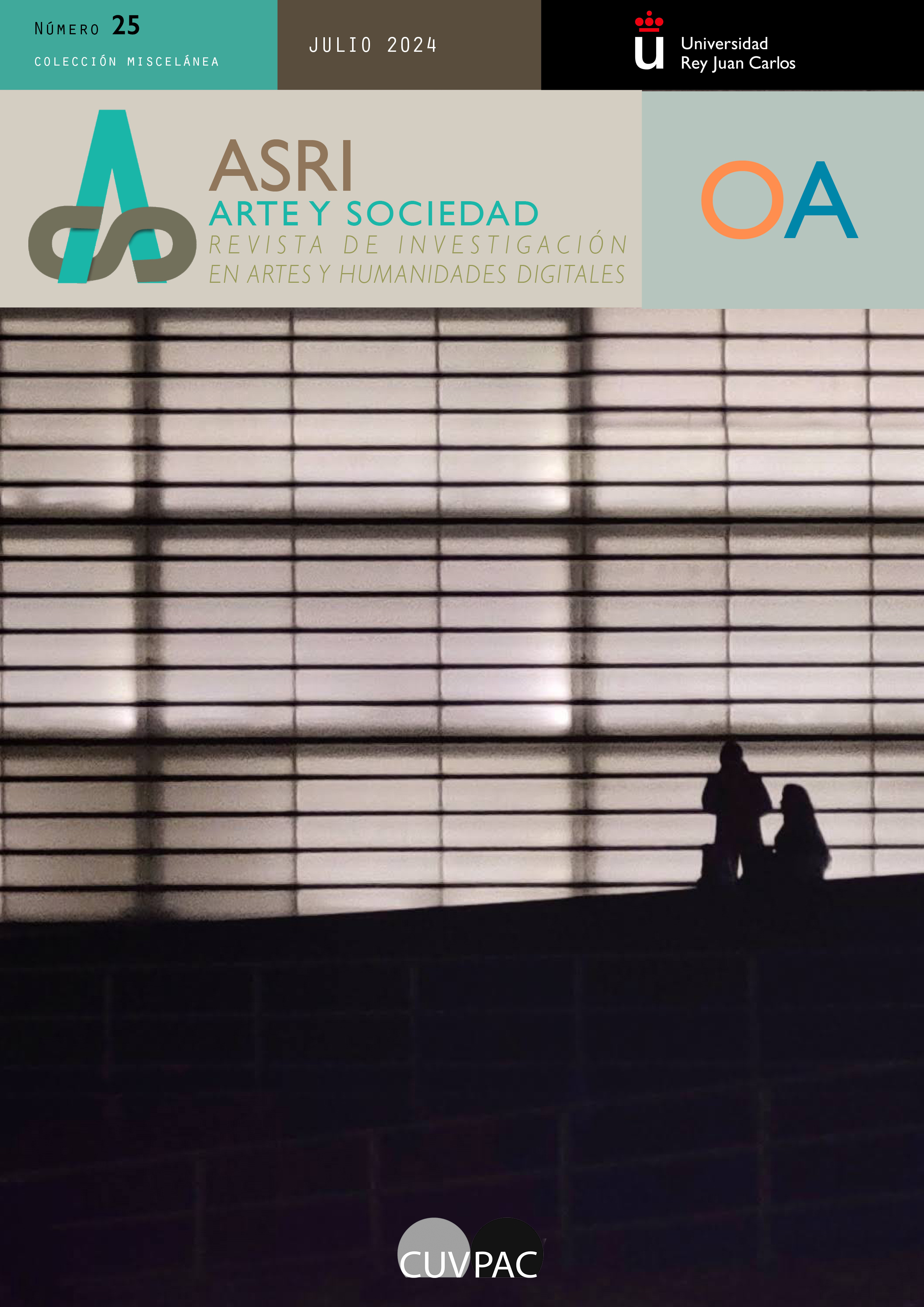
OpenASRI. Misceláneous Journal
No. 25 (2024)Explorations in Contemporary Art and Technology
This issue of our academic journal offers a deep and multifaceted view of the intersections between contemporary art, technology, and culture. Through eleven articles, 30 authors, and more than 17 universities —4 of them international— we delve into various aspects that redefine artistic perception and practice in the current context. The first article examines post-digital recycling in contemporary art, highlighting the works of Almudena Lobera, Mario Santamaría, and Román Torre. Reappropriation strategies that subvert technological consumption habits are explored, creating hybrid objects that challenge traditional notions of art. Artificial intelligence and its impact on art is the central theme of the second article. Here, the debate on the legitimacy of AI-generated art is discussed, addressing issues of creativity, plagiarism, and the possible trivialization of art. This article contextualizes concerns and hopes about the integration of AI into human creativity. The third article presents a systematic review of the use of machine learning and computer vision algorithms in the preservation of cultural heritage. Various techniques and their transformative potential for the conservation of works of art are highlighted, offering a new perspective on the history and context of works of art. The fourth article examines information visualization in urban environments through artistic productions that configure a hypermediated city. Metaphors of physical-digital reality and how these productions impact the perception of the urban landscape are analyzed. The fifth article reflects on museums as learning spaces, based on collaborative research with the Andalusian Center for Contemporary Art. Malgorzata Mirga-Tas's exhibition is used as a case study to explore the educational and formative impact of museum experiences. The exploration of video art as a means of challenging gender stereotypes is the focus of the sixth article. It analyzes how women artists use video art to deconstruct gender narratives and promote a transformation in social perceptions. In the seventh article, multidisciplinary stage proposals that connect dance, body, video, and interactive devices are examined. How creation with code has transformed these practices is analyzed, highlighting their transdisciplinary potential. The eighth contribution narrates an educational practice in the use of generative AI in the university environment, exploring the relationship between texts and generated images and their impact on the creation of work materials and final projects. The ninth article details a lighting intervention using video mapping in vernacular buildings in Chile, highlighting the value of visual arts as tools for analysis and cultural appropriation. The analysis of the morphology of the Valdivia Culture in the tenth article offers a deep understanding of its ceramic forms, generating new graphic codes and contributing to contemporary visual literacy. Fhe eleventh article analyzes games as an artistic medium from aesthetic, symbolic, and narrative perspectives. Through surveys and observation, it evaluates public perception, showing positive changes towards interactivity and the appreciation of games as an art form. Finally, the last article examines the role of the cuplé, with José Padilla as one of its greatest exponents. This text analyzes the presence of the cuplé in three international films, highlighting its specific functions in their soundtracks. It concludes that Padilla's cuplé diverges from the cultural stereotype of Spain.
Editors: Tomás Zarza & Miguel Sánchez-Moñita
-
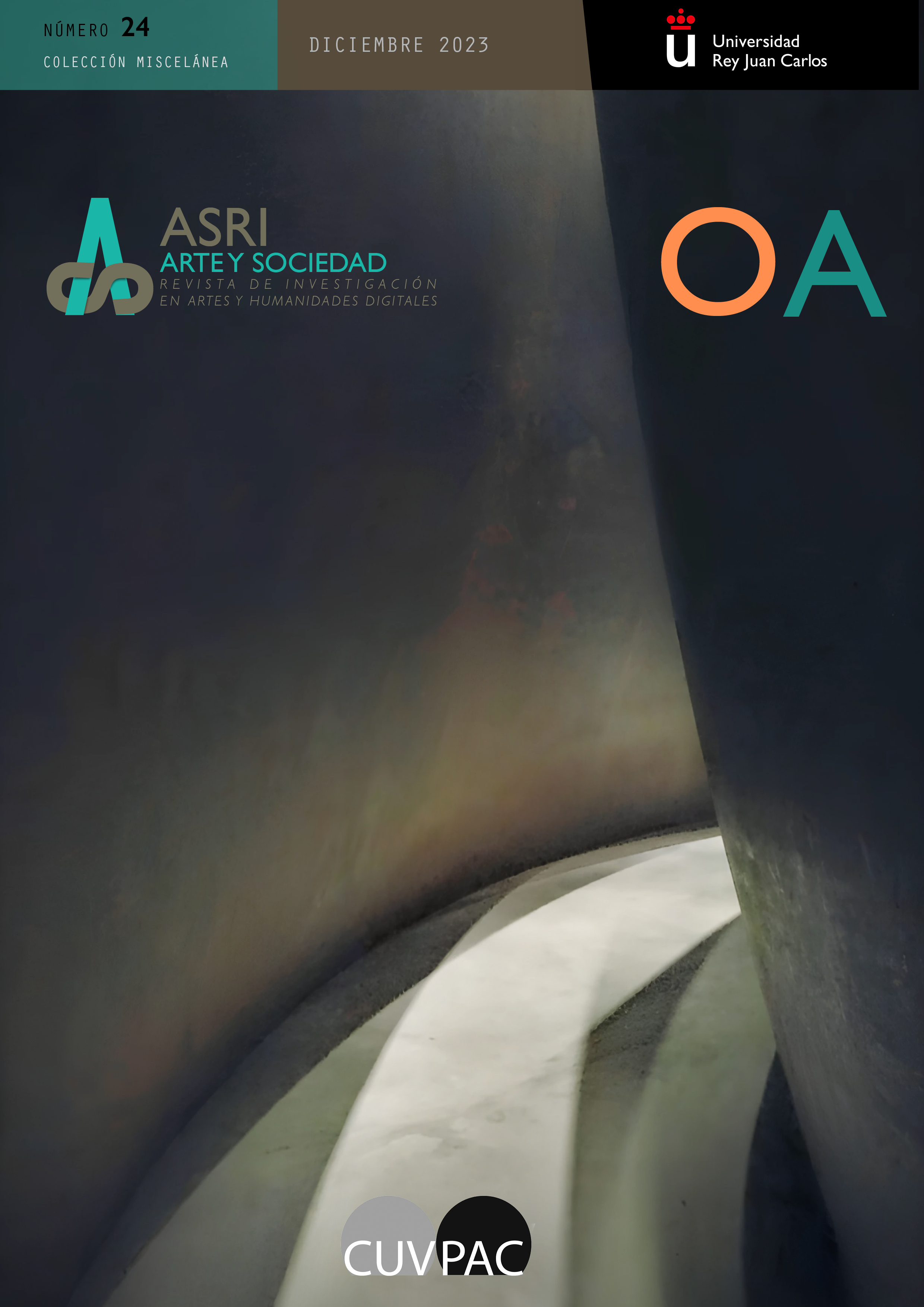
OpenASRI. Miscellaneous Number
No. 24 (2023)The issue compiles the work of 6 researchers who address topics ranging from fashion film, visual misinformation on social networks, scientific photography applied to herbaria to pedagogy from art and artists. These research works converge in the exploration of various aspects of image and art from multiple perspectives.
One of the essays highlights the role of color in fashionable audiovisual creations, showing how artists such as Sonia Delaunay and Eugenio Recuenco use visual technologies to express narratives in which color acquires a prominence comparable to that of the characters. Another text examines the phenomenon of misinformation on social networks, specifically on X (formerly Twitter). It addresses the issue of the spread of hoaxes in the context of migration, specifically in the Aquarius case, examining the spread of hoaxes through images manipulated or taken out of context, to support false information. The need for verification tools based on reverse image search is highlighted as a crucial measure to combat disinformation. The study on taxonomic photography in herbaria is another contribution that reveals the intersection between the classification of the natural world and its artistic representation and shows how the classification of the natural world has influenced both botanical photography and contemporary art. Furthermore, it proposes a critical re-reading of the representation of the plant kingdom, challenging the conventional perception of what is real and what is simulated through contemporary photographic projects. Finally, the pedagogical meaning of artistic disciplines is addressed from the artists' vision, demonstrating that beyond transmitting knowledge, these disciplines become tools that shape life philosophies, strengthen value systems, and generate a sense of freedom and passion. for artistic creation. Through a study with interviewed artists, it is possible to express how art contributes to the formation of their philosophy of life and strengthens our axiological system. Together, these works offer a comprehensive overview of the multiple dimensions of the image, from its function as a means of artistic expression in fashion to its role in contemporary misinformation and its influence on the visual representation of nature. These investigations focus on different aspects of image and art and converge to show how technology, visual representation, and artistic disciplines can influence each other, revealing new forms of expression and reinterpretation in the contemporary artistic field.
Thus, we say goodbye to the year by thanking, as always, the entire open knowledge community, the authors for trusting in the project, and above all, our tireless blind evaluators, without whom we would not be able to maintain the journal. We also say goodbye to the year with the entry of ASRI into two large evaluative databases: Redalyc; ICI Index Copernicus Master List
Editors: Tomás Zarza y Miguel Sánchez Moñita
-
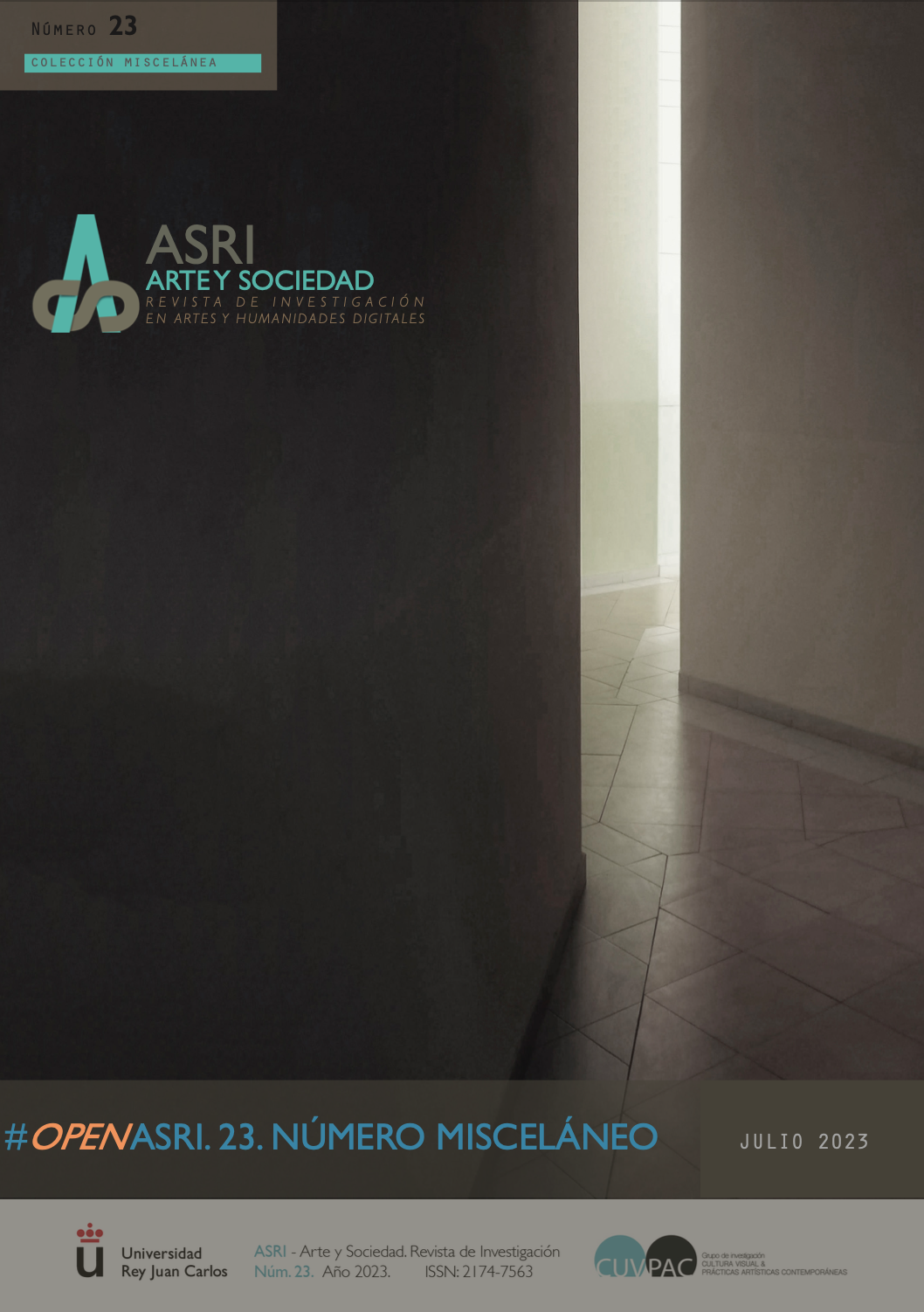
OPENASRIASRI. Miscellaneous Number
No. 23 (2023)This number includes the works of ten researchers and four researchers who approach our cultural present from notions such as post-digitality, the veracity of the images, and the pose; all of them far from the classical deterministic vision and commonly associated with technological discourse. Speaking of technological influences, we published an article on the rise of the podcast in the academic field whose main objective is to formulate a character analysis methodology in radio fiction, applying it to the case study of the series Negra y Criminal, by Mona León Siminiani. We have also selected an investigation interested in the modes of institutional cinematographic representation, (M.I.R.) as defined by the film theorist Noël Burch, which transgresses the limits of the spatial dimension and which is analyzed in the article with the aim of drawing an intertextual approach. and intermedial to the scenographic conceptions that are also mixed and transferred between theater, painting, or cinema. In the line of visual narrative studies, we offer you a review of Basque video art from the eighties and nineties, as a key element for the development of video art at the state level and whose works stand out as those made from the reuse of images from magazines. feminine. Along the same lines, on the importance of visual narratives and the discourses of hegemonic history, we offer you an article on the cartographic contributions of the peoples subjected by colonization and marginalized by the visual regimes of the West that begin to come to light in the last decades. Counter-cartographic practices of representation that, —located at the limits of traditional cartography— are today used as tools of resistance in colonial and neocolonial narratives. Another proposal has to do with the imminent disappearance of the generation that lived through the civil war, together with the fear of losing their testimony, has generated new memory recovery processes focused on intergenerational transmission. The article analyzes these aspects taking as a starting point six works created during the first years of the s. XXI. To finish, we offer you a research paper on visual anthropology based on the analysis of an image by the local photographer from Alcántara (Cáceres) Remigio Mestre, whose central motif is a Renaissance window in which two aviary cages hang. Finally, we offer you a research paper on visual anthropology based on the analysis of some images by Remigio Mestre, a photographer from Alcantarino (Cáceres). Thank you very much and congratulations to all the people involved who make this open knowledge community possible because we are launching this issue with the FECYT 2023 seal, obtained in the 8th edition of the evaluation process of scientific journals and with indexing in SCOPUS.
Editors: Tomás Zarza & Miguel Sánchez Moñita
-
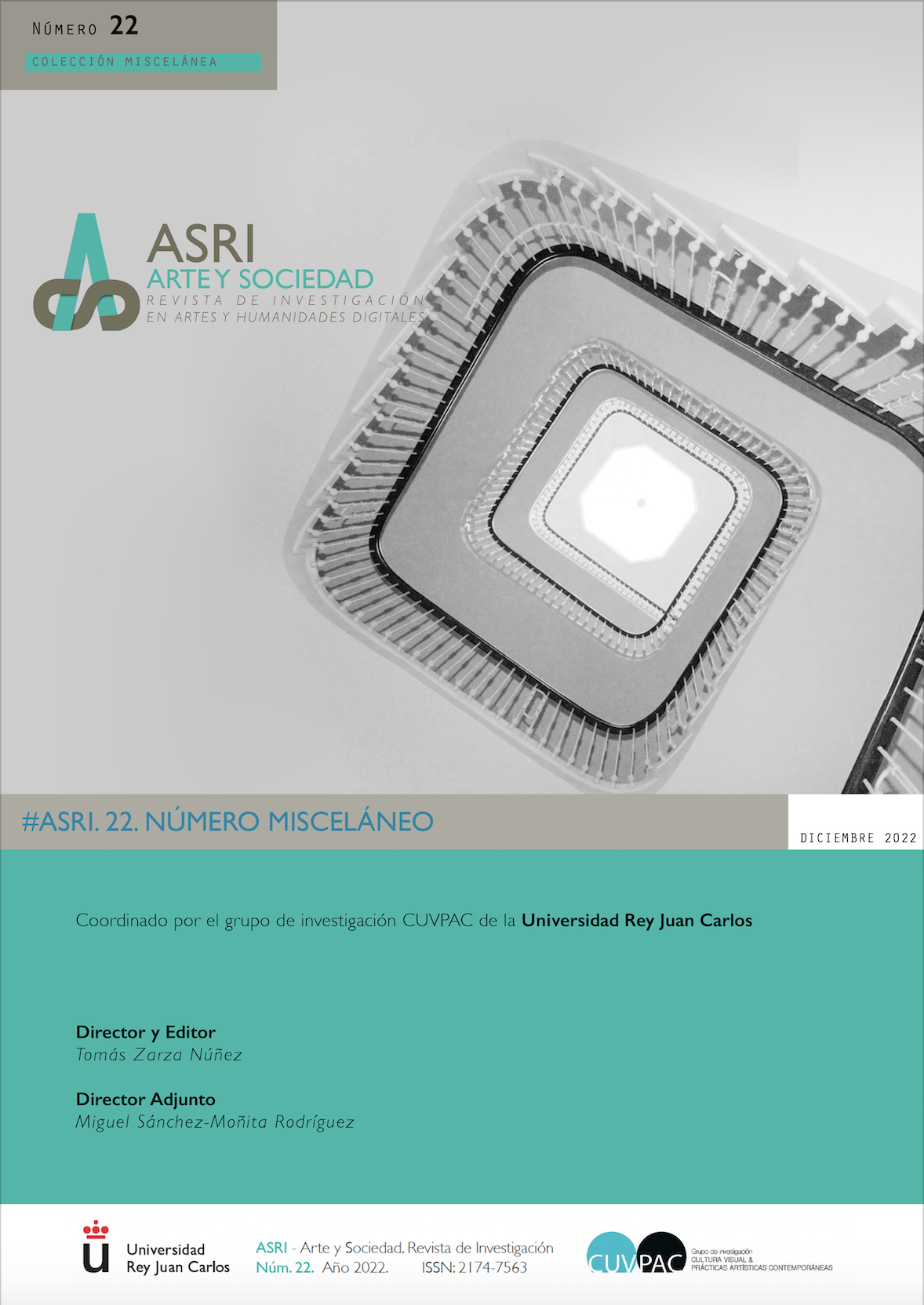
OPENASRI. Miscellaneous Number
No. 22 (2022)This number collects the research papers of researchers who, published in English and Spanish, map the fields of photography, music, art history, and design strategies. Papers that develop evaluation methodologies in the field of music; of the dissemination of history through Art; landscape photography from a gender perspective; the methods of production and reproduction of distinguished models of the IZO institute of artistic culture in Moscow and the analysis of methodologies and areas of action of strategic design. A set of varied and complementary investigations, which perfectly fit the interests of our journal. As always thanks to all the people who make this publication possible. We incorporate a new EPUB download format to guarantee the best reading of published texts on any electronic device without the need for uncomfortable zooming and scrolling on the screen.
Editors: Tomás Zarza & Miguel Sánchez Moñita
-
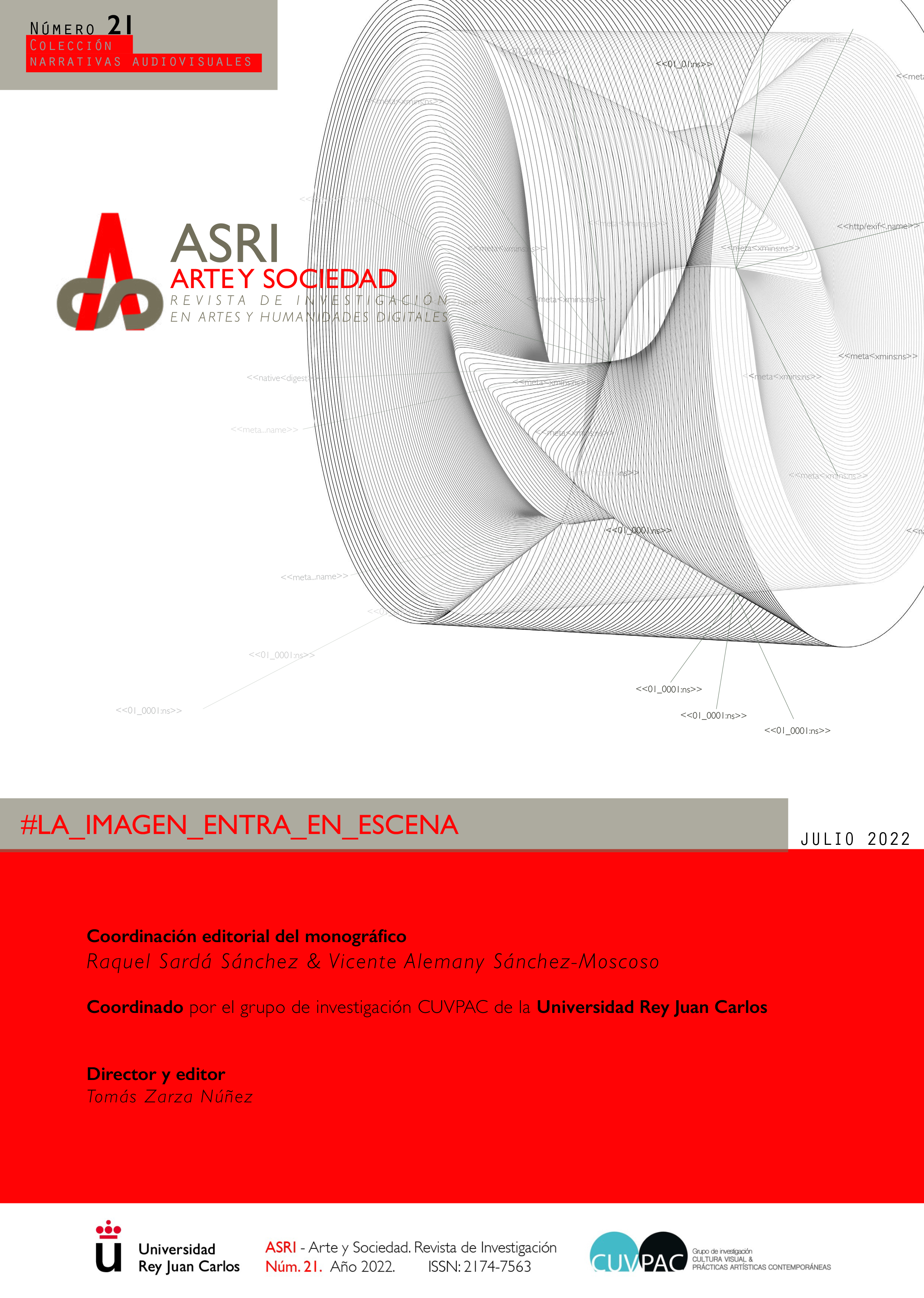
The image enters the scene. Digital creations in the scenic field, urban space and natural space
No. 21 (2022)Theater, dance, opera, circus, music, and visual arts are building new cartographies in the performing arts thanks to the insertion of ICTs in their immersive shows and generating new audiences. Our cities are filled with screens that mediate our perception. How are these new technological expressions intervening in the relationship with our environment? Light Festivals are becoming more common in our cities, as are immersive shows. This democratization of aesthetic enjoyment based on technological proposals is associated with the risk of confusing the artistic work with its staging, often spectacular and markedly virtuosic, making it necessary to critically reflect on this phenomenon. New technologies allow complex relationships to be established between the image, the scenic, natural or urban space. Visual experiences leave the screens of our personal devices and conquer new supports, formats, and creative proposals. Digital photography and video projections and interactive lighting effects offer us multiple possibilities for creation, interpretation, and innovation in the construction of experiential spaces. All these new artistic manifestations generate innovative and multidisciplinary research proposals. From a critical artistic point of view, this open call brings together those researchers who have dealt with the use of digital and analog images to create spaces or transform existing ones in search of new meanings in the field of image cultures.
Editorial coordination: Raquel Sardá and Vicente Alemany
Direction and editing: Tomás Zarza and Miguel Sánchez Moñita
-
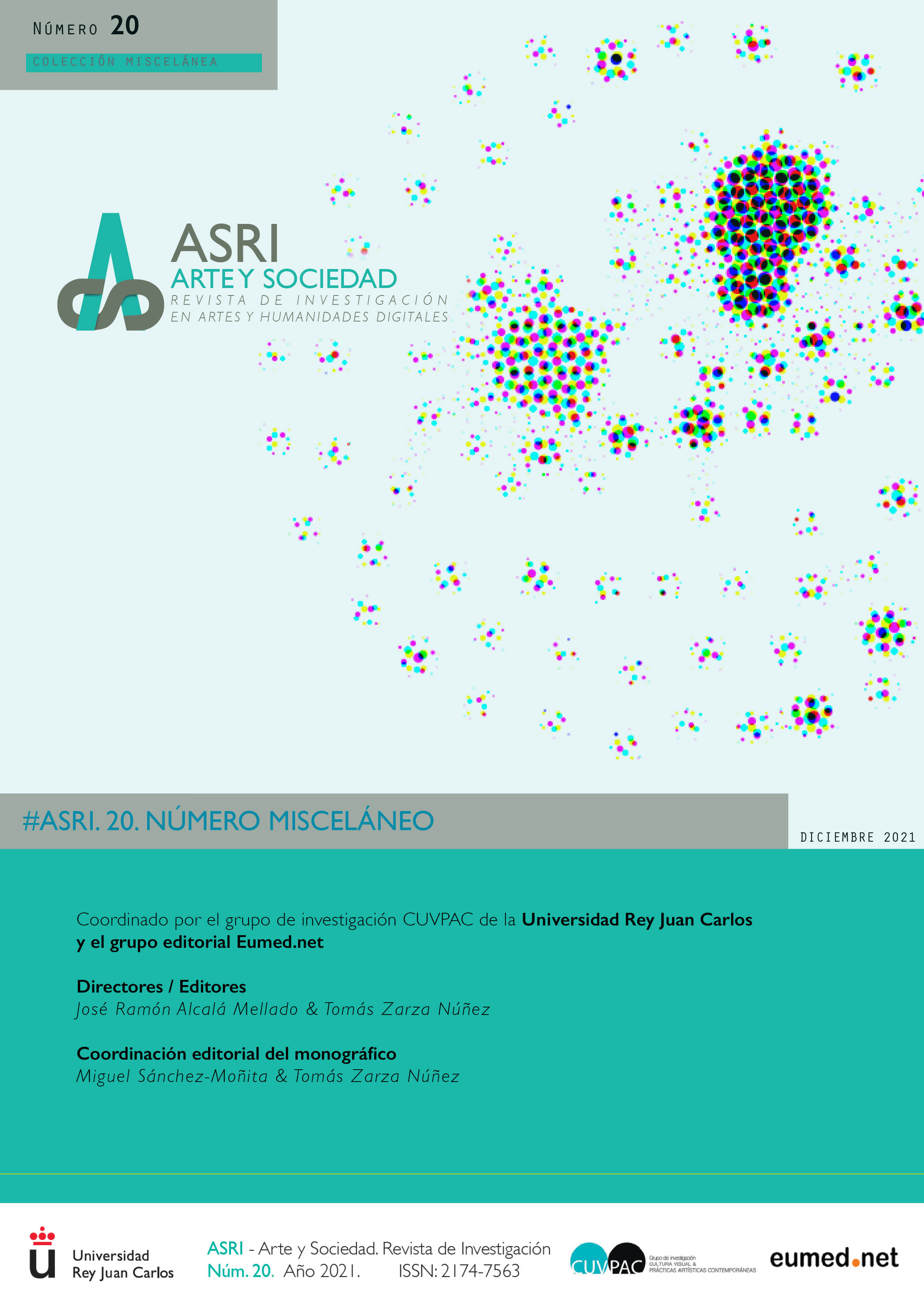
OPENASRI. Miscellaneous Number
No. 20 (2021)This issue includes a set of open articles that have been sent to the ASRI magazine within its #OPENASRI section. A section that is not governed by the requirements of a Call for papers for a monographic topic.
In this miscellaneous issue, 7 authors and researchers who have focused their work on fields as important as the limits of representation and the creative act; the segmented conception of time in contemporary artistic production; the vision of surrealism from a feminist perspective; the flirtation of painters like Pablo Picasso in the use of early 20th century vision technologies; the detailed study of the measurements of Goya's house where his Black Paintings were made; the autobiographical look at contemporary photography and finally, the analysis and importance of the art biennial system before the COVID-19 pandemic. We publish a new issue that was born with the aim of adding the different voices of research in Art without the impositions of monographic issues, with the aim of adding from the diversity of thought and the transversality of the branches of knowledge. So, we hope, as always, that you enjoy and learn from reading as we have. Thank you for reading us.
Director and Editors: Jsoé Ramón Alcalá & Tomás Zarza
-
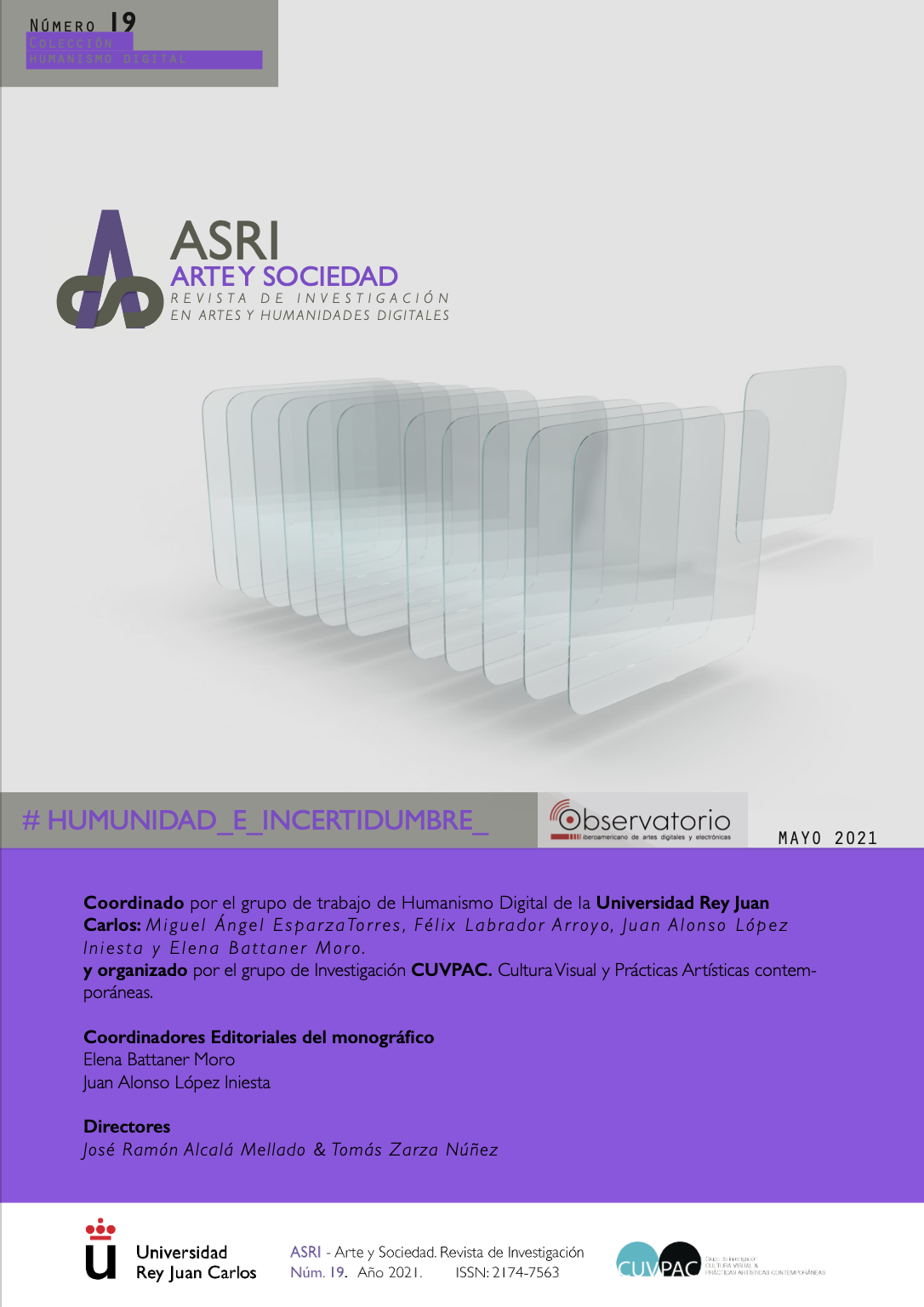
Humanity and Uncertaninty
No. 19 (2021)With these lines we want to present this new volume 19 of the ASRI magazine. Art and Society. It is difficult to evade the events that we are experiencing due to the COVID-19 pandemic and that affects all orders of our lives in very different ways. For this reason, and despite the difficulties of all kinds, we are very pleased to present this number that, in a certain way, aspires to the continuation and normality so longed for. As we pointed out in this issue's call for contributions, it's all happening very fast. Virilio's concept of acceleration –and the global accident– have taken shape on a planetary scale, so that the pandemic has placed us at the same time and globally in a multitude of spaces and places, including the spaces of thinking and writing. From the research objectives of the ASRI magazine, we have wanted to join it by inviting authors to reflect and give a place or an attempted response, through art and the humanities, to everything that, in a digital existence , still constitutes us as human beings. Thus, this 19th issue of ASRI magazine. Arte y Sociedad has a multidisciplinary and transdisciplinary vocation that we can find in the twelve contributions of this number and that are presented in the form of articles, essays and results of different artistic practices, and that make it a volume open to digital humanism. We do not want to finish without especially thanking all those people who have been part of this volume for their work, either in the authorship, or in the revision or editing of this issue: despite the numerous difficulties that we are encountering day by day, all of them have made a beautiful collaborative effort and have been able to find small –or big– moments to continue building these places where, once again, we can meet.
Editorial coordination: Elena Battaner and Juan Alonso Iniesta
Direction and editing: José Ramón Alcalá and Tomás Zarza
-
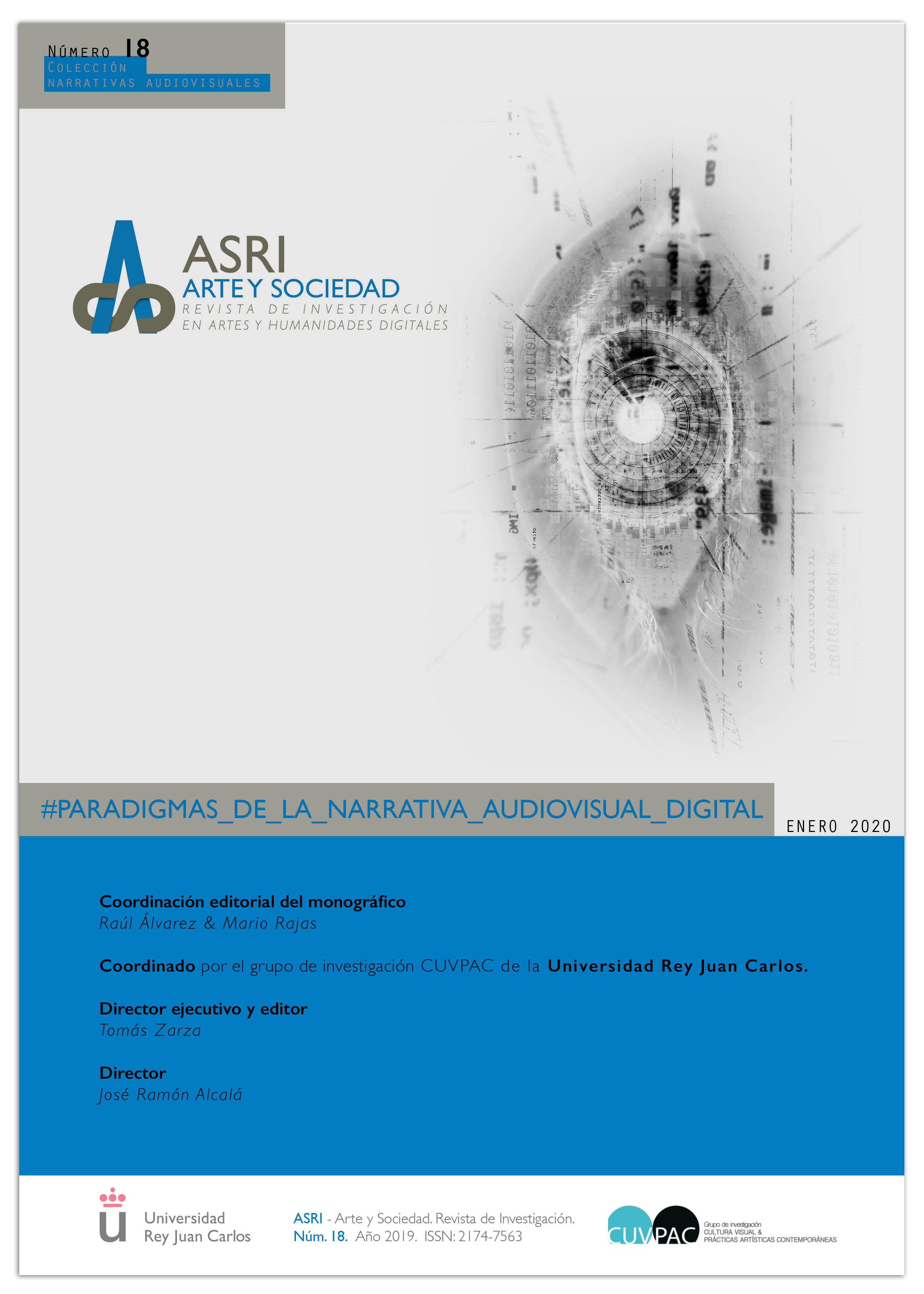
Paradigms of Audiovisual Narrative
No. 18 (2020)It is often said that in the Odyssey all human thought is and fits. It is the journey of journeys, life, and therefore nothing escapes the Homeric poem, whether they are questions of philosophy, politics, ethics or culture. For a student of narrative, in particular, the story of Odysseus is the mold from which all possible stories come. And most importantly, the forge from which all the possible ways of telling those stories come out. Even the ones that don't exist yet. Homer is adventure and mystery, tragedy and drama, emotion and delay. He is "narrating for the pleasure of narrating" (García Gual, 2015, p. XI), and from that irrepressible passion that feeds his verses, the infinite branches of the tree of narratology flourish. The 14 articles selected from our monograph, out of a total of almost 40 contributions received, navigate those rivers that flow into that great "flow of images" that makes up contemporary times, and which was dealt with in the previous issue of our magazine. Cinema, photography, video games, design, architecture, journalism, advertising, marketing, academic research, teaching... No field of communication escapes the mutations of the new audiovisual narratives. As nothing, not even oneself, can escape from its Homeric condition.
Editorial coordinators: Raúl Álvarez and Mario Rajas
Directors and editors: José Ramón Alcalá and Tomás Zarza
-

Images Flow
No. 17 (2019)This issue will dedicate its efforts to show a snapshot of all the theoretical and artistic practices that start and take the Internet as a social process of live exchange. A set of practices that use information flows as a form of social architecture, and that are capable of building knowledge from the circulation and collective spill of multiple knowledge.
A principle of online action that ceases to be a means of transmission and becomes a support for thought and raw material for experimentation. If the traditional artist found his source of inspiration in nature, today we must take the internet as a plural space of events where space for representation, time, authorship, content, audience, artificial intelligences and other manifestations make up a new definition of art.
The flows of the images in networks move us away from the old single-channel learning model that prepared us to be operators (time alienated), and they take us into a new paradigm where we are protagonists of our time.
Editorial coordination: Tomás Zarza y Miguel Sánchez-Moñita
Direction and editing: José Ramón Alcalá and Tomás Zarza

